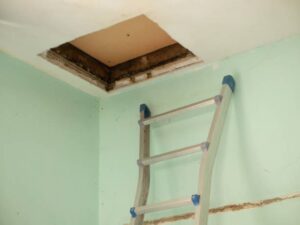Convenient and safe roof access is essential for building owners, facility managers, and cleaning specialists. This is where a roof hatch with a ladder can come in handy.
The image below shows a dangerous ladder section where a conduit between the wall and the ladder rungs obstructs the footing and handholds. This is a clear violation of OSHA safety regulations. For more roof access hatches with ladder, check this out.
Safety
Roof access hatches make rooftop maintenance and inspection easier, safer, and more convenient. They also provide a controlled entry point to the roof, which can help reduce break-ins, vandalism, and theft of rooftop equipment.
 Unlike wall ladders, which anyone can use, roof access hatches are only accessible to authorized personnel. They are also well-insulated, which helps maintain energy efficiency.
Unlike wall ladders, which anyone can use, roof access hatches are only accessible to authorized personnel. They are also well-insulated, which helps maintain energy efficiency.
Regardless of the type of roof access hatch you choose, installing safety railings according to OSHA regulations is essential. These safety systems are typically installed on the sides of the roof hatch that open towards the ladderway and any exposed sides. They are designed to supplement other forms of fall protection, such as personal fall arrest systems and netting, which may not be adequate. Adding the right safety features to your roof hatch can help protect workers from falls and injuries, which can be costly for businesses.
Convenience
Roof access hatches make it easy for contractors and maintenance personnel to reach the roof for routine inspections and repairs. This is especially important for homes and commercial buildings that must regularly inspect their roofing systems. This allows them to quickly address any issues, such as leaks or shingle damage, so the roof can last longer. For more roof access hatches with ladder, check this out.
In the past, people used caged ladders to access roof areas. However, these aren’t ideal for the safety of individuals or the protection of roof or rooftop equipment from unauthorized use. On the other hand, a roof access hatch allows a person to access the roof from inside the structure without having to climb a wall ladder that anyone can easily see.
For added convenience, most hatches’ opening and closing devices are gas-charged to allow users to open and close the door with one hand. These can also be fitted with a latching system that prevents the door from accidentally shutting on workers on the roof.
Durability
Specifying the correct roof access hatch for your building project is vital in ensuring the safety and convenience of the maintenance team. However, this has to go hand-in-hand with the durability and performance of the hatch and ladder types.
The best ladder access hatches are insulated and have a low thermal conductivity to ensure energy efficiency for the building. Milcor roof hatches are available in RB, RC, and RD models with a composite-design cover construction to achieve U-factors of up to 0.26.
Ladder access hatches can be combined with wall ladders, ship ladders, alternating tread ladders, and industrial stair systems to provide a safe and convenient rooftop entry option for your maintenance team. Replacement Skylights carries a wide range of ladder access hatches and associated products, so contact us to help select the right one for your building project. Our friendly team of experts is happy to offer advice and recommendations. We also have a free online design tool to help you determine what size ladder access hatch is required for your project. For more roof access hatches with ladder, check this out.
Installation
A specialized roof access hatch is ideal for those who need to move equipment or supplies up onto the rooftop. This hatch type features a lightweight, fold-down ladder that stores easily in the ceiling. It also has a dual locking function, enabling users to maintain three points of contact with the ladder when transferring items.
Another advantage of a roof access hatch is that it can be integrated with a wall ladder, ship ladder, alternating tread ladder, or industrial stair to provide safe and convenient rooftop access. This eliminates the need for a fixed caged ladder, which not only detracts from the aesthetic value of the building but can be dangerous for workers because of its lack of footing and handholds.